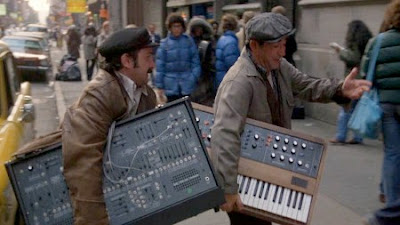OP-1 May 2013 OS Update - DNA and CWO
Published on May 29, 2013 djthomaswhite·83 videos
Additional videos below.
"This video is an introduction and demo of the May 2013 OS update to the amazing Teenage Engineering OP-1 synthesizer music machine. In this update two astounding new features are added in the form of the "DNA" synthesizer engine and the "CWO" Frequency Shifting Delay. The DNA engine is a noise engine capable of complete aggression and fax machine battle while at the same time possessing the ability for harmonic tonal leads and chords. The CWO FX is a Frequency Shifter with a wide range that make it possible to do phasing, flanging, chorus, tremelo, ring mod and comb filter types of sounds. You have to hear it to believe it. CWO also represents the first partnership by Teenage Engineering with an outside developer to co-op code to add to the OP-1's already heavy arsenal of sound capability. This developer is the one and only sonic master mind Magnus Lidström of Sonic Charge.
I hope you enjoy the video and the demo. There is a longer video with more blabber and explanation of what is going on here http://youtu.be/WntQUO0A6qw (Keep in mind that the visuals you see were from a beta build and show graphics which have since been refined and polished. It's actually a good preview for those of you who wonder what steps are involved in an OP-OS Beta Testing process. Soon you will be able to upload this OS yourself and I look forward to hearing (and seeing) what you can create with this as well as part of the OP community.
The Song played on the iPhone in this demo is from my band Santoma and is called "See Me." We have other songs on Large Music and are planning the release of our completed downtempo/lounge album soon.
Note: This is a pre-release build and final features may vary slightly from those shown in these clips. All music is original and no creative rights have been infringed upon in the making of this video."
And the PRESS RELEASE followed by a longer version of the video above:
"Finally here, the new OP-1 OS is ready! This time we're again adding something completely new. For the first time in the history of the OP-1 we have teamed up with an external developer and invited them to create something fresh and unique for our unit. The result of this first collaboration is something truly spectacular.
CWO - Frequency Shifting Delay

From the sonic master mind Magnus Lidström of Sonic Charge comes CWO
We first met Magnus Lidström a few years ago at a developer party here in Stockholm, Sweden. Even before that we have all been huge fans of Magnus' work, such as Microtonic, Synplant and Bitspeek. When first thinking about doing something together for the OP-1 platform we discussed what could be ported. We soon came to the conclusion that an effect would fit really well. Inspired by Magnus' own Echobode, the new CWO effect is a frequency shifting delay with a twist, modified for the OP-1 format.
'I like the limitations. The four knobs on the OP-1 have been highly optimized, so that each one produces a drastic change in sound on its own. This combination of effects is uncommon and capable of producing a wide arrange of sounds, such as phaser, flanger, tremolo and dub echo. It is really good on drums and for making simple sounds more fun and complex.'
Magnus Lidström, Sonic Charge
We made the graphics for CWO to resemble a cow, digesting and processing the audio signal through it's four stomach compartments, producing a very unique result. We hope you will like it and look forward to hearing your sonic experiments! Chew away!
DNA - CPU ID Noise Synthesis

Also new in this update is a completely new synthesis engine: DNA
The new DNA synthesis engine adds CPU ID Noise Synthesis, meaning it's a noise synth, based on the Analog Devices 64-bit Blackfin processor ID, unique to every single OP-1 unit. Every synth will therefore potentially have a slightly different sound. Sometimes tonal, sometimes not, this engine adds a truly expanded sonic pallet to the OP-1. Filter, Wave number, Wave modifier and Noise can be directly controlled via the knobs. The DNA graphics is set to resemble a Kaleidoscope, where sound and visuals are abstractly interlinked. Developed in-house.
OS intro video by DJ Thomas White
INTRO VIDEO BY DJ THOMAS WHITE [video above]
Long time OP-1 user and beta tester DJ Thomas White made a sweet video introduction and demo of the OS update.
Watch and listen as he explores the power of DNA and CWO, resulting in a wide array of sounds, all created with the new OS. Available as a free preset pack!
Thanks Thomas!"
Teenage Engineering OP-1 May 2013 OS Update
Published on May 29, 2013 djthomaswhite·83 videos
"(Introductory NOTE: This is a longer original introduction to the new OS that I put together. It has outdated graphics that have since been polished. This is one example of what takes place during beta testing. All sound features are unchanged. There is a much more in depth level of explanation of operation of the new OS here and it would be a shame to have this sit on a shelf... so here you go.)"
And one by kubistah:
Teenage Engineering OP-1 DNA Synth Visuals
Published on May 29, 2013 kubistah·13 videos
 2. Fame Synths: ARP 2600, MOOG Minimoog
2. Fame Synths: ARP 2600, MOOG Minimoog 



























































